Physical Address
304 North Cardinal St.
Dorchester Center, MA 02124
Sebaceous glands are normally found in association with a hair follicle. However, at several mucosal sites, they may develop independently, presenting as small 1- to 3-mm yellow to white papules (Fordyce spots), which can be accentuated when the mucosa is stretched. Lesions of the oral cavity commonly present on the vermilion border of the lip and the buccal mucosa. On the vulva, Fordyce spots affect the medial aspect of the labia majora while in males the glans penis is involved. Prevalence varies, but some large studies place the incidence of oral lesions at greater than 25%. Incidence increases with age since Fordyce spots are not commonly seen in infants. They are of little consequence and likely represent a normal physiological variant since such a large proportion of the adult population is affected. Rarely, lesions on the lip become a cosmetic nuisance.
Similar tiny papules are sometimes seen on the areola of the female breast where they are known as Montgomery tubercles. These may be associated with vellus hairs or lactiferous ducts, and occasionally in adolescence they are complicated by the development of a small breast lump, which discharges thin secretions. Such lesions tend to resolve spontaneously. Sebaceous hyperplasia of the areola has been reported in both women and men (see below), but its relationship to Montgomery tubercles (if any) is unclear.
Occasionally, ectopic sebaceous glands have been identified in the esophagus, gastroesophageal junction, uterine cervix, vagina, sole of the foot, thymus, and tongue. Rarely, these lesions have been described as extensively involving the esophagus.
These lesions are all characterized by the presence of well-formed lobules or small clusters of sebocytes located high in the lamina propria and opening directly onto the epithelial surface.
Sebaceous hyperplasia is a common condition that is frequently clinically misdiagnosed as basal cell carcinoma. It most often presents on the face of older adults, particularly males ( Fig. 32.1 ). Lesions are, however, occasionally encountered in children. The forehead and cheeks are predominantly affected, and occasionally diffuse facial involvement occurs ( Fig. 32.2 ). Other less common sites include the chest, ocular caruncle, penis, scrotum, and vulva. A linear variant presenting has been described on the penis, head and neck region, and chest.
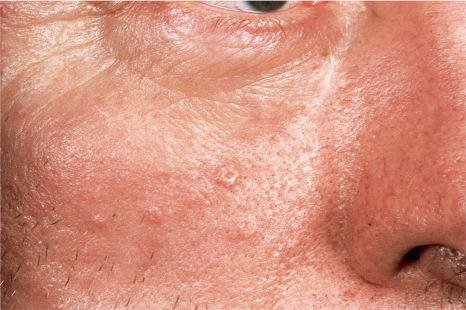
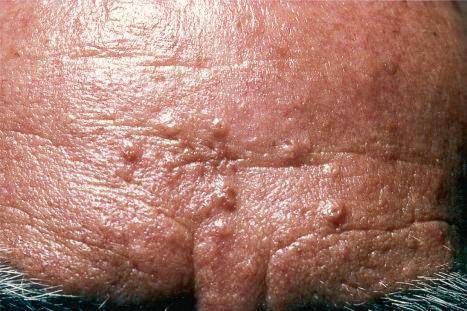
Lesions – which may occur individually, in groups, or as a sheet of papules – present as yellowish, dome-shaped asymptomatic papules 1–2 mm in diameter. Larger variants measuring 1.0 cm or more in diameter are occasionally seen (giant solitary/senile sebaceous hyperplasia). The papule is umbilicated, and individual lobules emanating out from the center can often be identified with a hand lens. Distinctive dermatoscopic features including cumulus sign, crown vessels, and milia-like cysts have been described.
Rarely, postpubertal sebaceous hyperplasia occurs, either as an isolated phenomenon or more rarely in association with anhidrotic ectodermal dysplasia. Familial cases, sometimes with early onset, have also been described. One variant is termed presenile diffuse familial sebaceous hyperplasia. Sebaceous hyperplasia is significantly increased in transplant patients, particularly in males following renal transplantation, and this is likely to be related to therapy with ciclosporine A. Eruptive cases in this setting are rarely described. A case in an immunosuppressed patient with Senear-Usher syndrome (pemphigus erythematosus) has been reported.
Ectopic sebaceous glands with associated hyperplasia have been described in the oral mucosa and on the areola where lesions may be bilateral (areolar sebaceous hyperplasia).
Although sebaceous development is profoundly affected by androgens, their mode of action in sebaceous hyperplasia may be limited. Since these lesions do not regress, it is unclear that they truly represent hyperplasia, which is a reversible phenomenon. Nonetheless, the name sebaceous hyperplasia is certainly indicative of a well-defined clinicopathological entity.
Studies have indicated that overexpression of the mEDA-A1 splice variant of EDA which encodes ectodysplasin, a member of the tumor necrosis factor (TNF) ligand family, induces sebaceous hyperplasia in transgenic mice. This transcription factor is involved in skin adnexal development, acting through the nuclear factor-kappaB (NF-κB) and JNK pathways. Hemizygous EDA pathogenic variant males (X-linked) or biallelic pathogenic variants in EDAR , EDARADD , or WNT10A pathogenic variants in males or females cause hypohidrotic ectodermal dysplasia (HED). The relevance of this finding to human sebaceous hyperplasia remains to be determined, although interestingly and perhaps incongruously, sebaceous hyperplasia as mentioned above has been reported in the setting of HED.
Very recently, activating mutations in HRAS , KRAS , and EGFR have been documented in a subset of sebaceous hyperplasia, suggesting that despite the term hyperplasia, these lesions might be best considered as neoplasia.
In solitary papules, the individual gland is hyperplastic and situated higher in the dermis than normal ( Fig. 32.3 ). Individual lobules are increased in number but are not appreciably different in size compared with normal sebaceous glands. The individual lobules drain into a central duct, which is often associated with a hair follicle, through single or multiple follicular infundibula ( Figs 32.4 and 32.5 ). In confluent lesions, multiple sebaceous glands are similarly affected. In both variants the dermis is normal, except for a variable degree of elastosis.
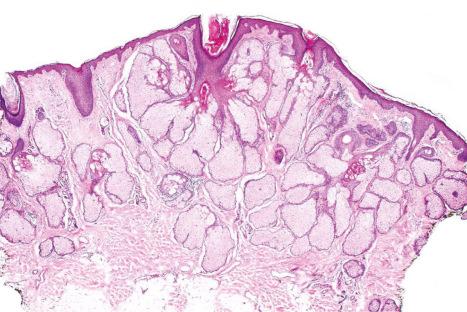
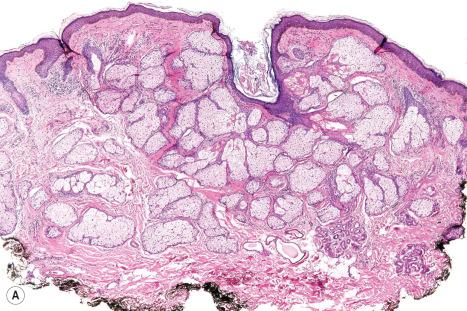
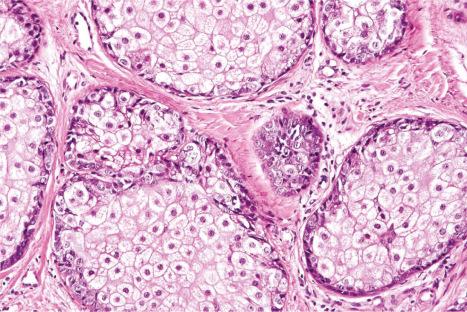
Mucosal sebaceous hyperplasia is not associated with a hair follicle, and the lobules empty into a single duct that opens directly onto the surface.
Sebaceous hyperplasia overlying a benign fibrous histiocytoma (dermatofibroma) has been documented, including its dermatoscopic features.
Nevus sebaceous (Jadassohn, organoid nevus) is not uncommon and often presents at birth although it usually does not cause the patient to seek medical attention until the second to fourth decades. Lesions have been described in up to 0.3% of neonates. The sex distribution is equal.
Nevus sebaceous is single, round or oval, well circumscribed, and usually measures 1–6 cm in greatest dimension. It commonly affects the head and neck, particularly the scalp where it presents as a yellowish, flat, or mamillated patch of alopecia ( Fig. 32.6 ). Other sites of predilection include the forehead, temples, around the central face, and behind the ears. Rarely, lesions have been documented at other sites including the trunk, breast, limbs, oral cavity, external auditory canal, and perianal region. It becomes rather warty during childhood and in adolescence shows marked enlargement with development of a waxy surface under the influence of pubescent hormonal stimulation. In adulthood, any further change is likely to be due to the development of a range of usually benign but sometimes malignant tumors of variable differentiation ( Fig. 32.7 ). Less frequently, nevus sebaceous presents as a linear lesion, often behind the ear. Sometimes the lesion is very extensive, and a zosteriform variant has been noted. A few cases of familial nevus sebaceous showing paradominant transmission have been described.
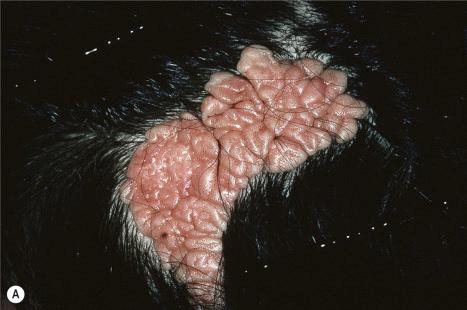
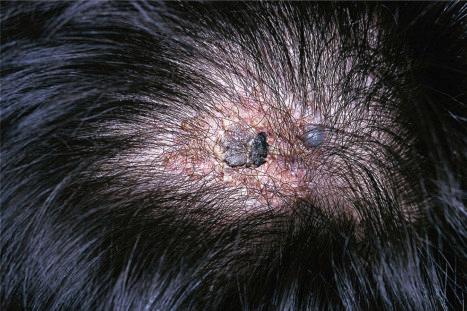
Very rarely, congenital nevus sebaceous is associated with other abnormalities, particularly neurological symptoms. Involvement tends to be linear and frequently parasagittal with a wide distribution on the head and scalp, and sometimes it extends to the neck and shoulder. Most such cases are classified as linear nevus sebaceous syndrome, which presents with a triad of nevus sebaceous, seizures, and mental retardation. In practice, however, seizures and mental retardation are not regularly present. Ocular abnormalities are common and other organ systems may also be affected. The seizures are sometimes intractable to medical treatment and may require surgical intervention. Reported complications include unilateral megaencephaly, a hamartomatous intracranial mass, hemimegaencephaly, cerebral arteriovenous malformation, a desmoplastic neuroepithelial tumor, hemifacial asymmetry, complex conjunctival colobomas or choristomas, corneal dermoid, macular and optic nerve hypoplasia, optic glioma, nonparalytic strabismus, partial oculomotor palsy, microphthalmia, retinal detachment, sensorineural deafness, inner ear malformation with hearing loss, rickets, uvula bifida, premature tooth eruption, cleft secondary palate, and diffuse pulmonary angiomatosis. Extensive surgical resection with reconstruction may sometimes be required. This condition forms part of the Schimmelpenning syndrome (Schimmelpenning-Feuerstein-Mims syndrome, organoid nevus phakomatosis), which represents a distinct clinicopathological subset of the epidermal nevus syndrome. SCALP syndrome has been described as consisting of the combination of nevus s ebaceous, c entral nervous system malformations, a plasia cutis congenita, l imbal dermoid, and p igmented nevus.
Nomenclature and classification schemes for the epidermal nevus syndrome are complex, with overlapping entities and variable associated defects. Nevus sebaceous can coexist with other epidermal nevi, including verrucous epidermal nevus, possibly representing a continuum of manifestations.
Other rare associations, not clearly syndromic and perhaps incidental, include melorheostosis, mediastinal lipomatosis, and familial retinoblastoma. Nevus sebaceous has also been reported in a child with nevoid basal cell carcinoma syndrome. A nevus sebaceous has been reported as a paired phacomatosis pigmentokeratotica with speckled lentiginous nevus of the abdominal wall in which an embryonal rhabdomyosarcoma arose in one exceptional case.
Deletion of the PTCH gene has been reported in nevus sebaceous. The PTCH pathway is involved in cutaneous patterning and development. This finding has some relevance, particularly in the context of the disordered epithelium and appendageal structures characteristic of this lesion. However, such PTCH deletions have not been confirmed by others and additional research is necessary. More recently, nevus sebaceous has been recognized to be associated with RAS family mutations – primarily in HRAS (in particular, c.37G>C; p.Gly13Arg) and much less frequently KRAS . The condition is now conceptualized as a mosaic RASopathy produced from a section of skin with a RAS mutation. When not limited to the skin, these mosaic mutations can produce the more severe effects seen in some of the nevus sebaceous associated disorders. The diverse family of epidermal nevus syndromes appear to have similar genetic origins, though the characteristic mutations vary. A mouse skin graft model with nevus sebaceous-like lesions which appear to have been induced by aberrantly transplanted dermal fibroblasts has been described, demonstrating that stromal epithelial interactions may also be of importance.
Nevus sebaceous is a complex lesion comprising abnormalities of the epidermis, hair follicle, and sebaceous and sweat glands. The epidermis may be acanthotic or papillomatous and foci of abortive hair papillae-like proliferations are commonly seen ( Figs 32.8 and 32.9 ). The epithelium in older lesions sometimes contains foci of pale-staining glycogen-rich cells, suggesting outer root sheath differentiation reminiscent of trichilemmoma.
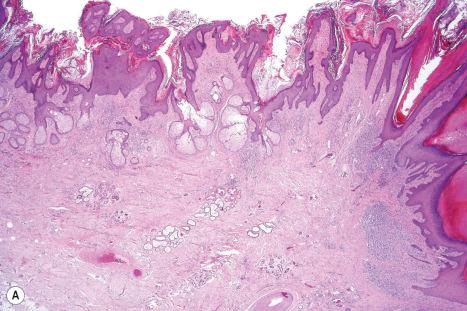
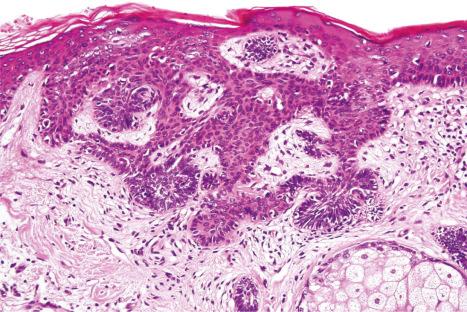
Sebaceous glands are variably hyperplastic and excessive, diminished in number, or even absent ( Fig. 32.10 ). In early infancy, the sebaceous glands often show a transient enlargement under the lingering influence of maternal hormones, but they then diminish in size until adolescence when they undergo marked proliferation. This is followed by a tendency to involution with increasing age. Virtually all lesions show irregularities of morphology and distribution of sebaceous glands. Commonly, they are located at an abnormally high level within the dermis, sometimes communicating directly with the surface of the epidermis ( Fig. 32.11 ). Often, they appear unrelated to a hair follicle. A punched-out defect at the periphery of a lobule is occasionally seen, presumably representing coalescence of several mature lipid-laden sebaceous epithelial cells.

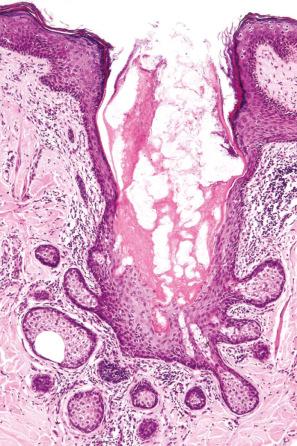
A very common finding is an absence or great reduction in the number of mature hair follicles. This is invariable in scalp lesions. In many cases, ectopic apocrine glands are present within the lower dermis.
Nevus sebaceous is frequently complicated by development of a variety of other benign cutaneous neoplasms including syringocystadenoma papilliferum, trichoblastoma-like lesions, trichilemmoma, sebaceous neoplasms, keratoacanthoma-like lesions, viral wart, seborrheic keratosis, giant cutaneous horn, spiradenoma, pilar leiomyoma, nodular hidradenoma, dermal lipoma, banal melanocytic nevus, combined blue and speckled lentiginous nevus, infundibuloma, apocrine cystadenoma, tubular apocrine adenoma, syringoma, and extramedullary hematopoiesis. Large studies indicate that syringocystadenoma papilliferum (2–5%) and trichoblastoma-like proliferations (2–7%) are the most commonly encountered lesions while trichilemmoma and sebaceoma are present in 2% to 3% of cases, with other lesions being less frequent ( Figs 32.12–32.16 ). The benign secondary lesions show associations with the site of the lesion and age of the patient. These benign secondary lesions show the same HRAS and KRAS mutations as seen in the nevus sebaceous; additional mutations have not been demonstrated. Many of the secondary tumors seen in nevus sebaceous are also associated with RAS family mutations when encountered outside of this context and thus are sufficient as a cause. Why secondary tumors are only seen in a subset of lesions is unclear. This process could be sporadic or perhaps be due to the mosaic nature of nevus sebaceous and thus which cell types and lineages harbor the mutations. Malignant tumors are much less often seen and include basal cell carcinoma, squamous cell carcinoma, melanoma, sebaceous carcinoma, eccrine porocarcinoma, dermal leiomyosarcoma, apocrine carcinoma, microcystic adnexal carcinoma, and trichilemmal carcinoma. These malignant secondary tumors have not been well studied for additional mutations. Historically, basal cell carcinoma was thought to represent the most common malignant neoplasm arising in association with nevus sebaceous with incidences reported as high as 20%. Other more recent studies, however, have much lower prevalences and indicate that the majority of cases of basal cell carcinoma arising in nevus sebaceous are more accurately classified as benign trichoblastoma-like lesions, although authentic basal cell carcinoma is occasionally seen, primarily in older patients (postpuberty). Both benign and malignant secondary lesions are more commonly encountered in adults, although children may also rarely be affected with malignancy being exceedingly rare. Nonetheless, the currently perceived scarcity of malignancy in childhood nevus sebaceous has called into question the necessity of early prophylactic excision. Nevus sebaceous not uncommonly shows multiple tumorlike proliferations. Sometimes, these defy precise classification.

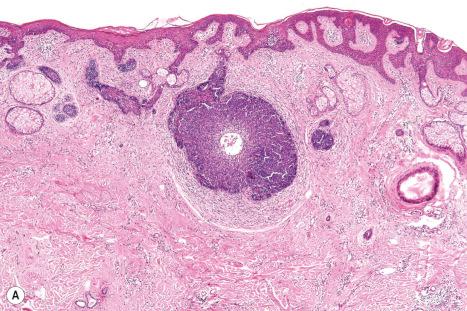
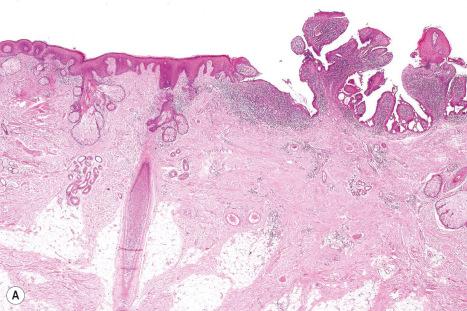
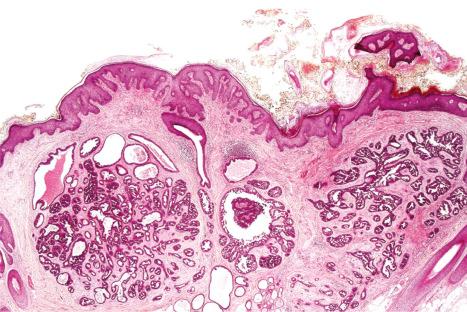
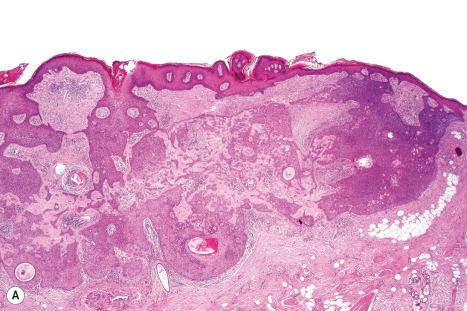
Steatocystoma multiplex, characterized by autosomal dominant inheritance, usually presents in adolescence. Some cases lack a family history and are considered to be sporadic. Although the sternal region is commonly affected in males, and the axillae and groins in females, lesions (which are invariably multiple) may involve most of the upper trunk and face. More localized variants presenting on the face, scalp, nose, acral sites, vulva, and scrotum have been described. Scrotal cases can show calcification. A linear form is very infrequently encountered.
Early small dome-shaped lesions are rather translucent, changing to a yellowish color with age ( Figs 32.17 and 32.18 ). Puncta are not obvious, but comedones are often associated features. Spontaneous rupture of the cysts sometimes results in steatocystoma multiplex suppurativum characterized by inflammation and scarring reminiscent of acne conglobata.
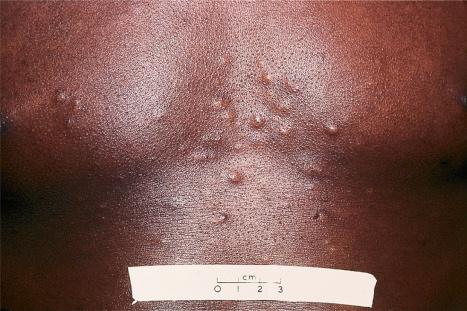
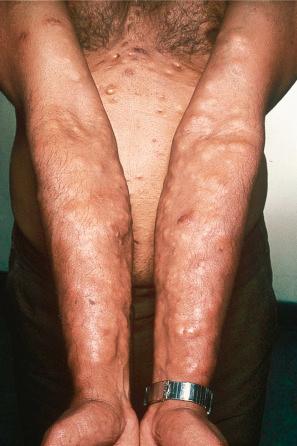
Rarely reported associations include natal teeth, hidradenitis suppurativa, bilateral preauricular sinuses, multiple trichoblastomas, familial hypobetalipoproteinemia, cerebellar ataxia, intracranial dermoid, LEOPARD syndrome (lentigines, electrocardiographic conduction defects, ocular hypertelorism, pulmonary stenosis, abnormalities of the genitalia, retarded growth with short stature, deafness), familial syringoma, polycystic kidney disease 1 (Alagille syndrome), and Lowe (oculocerebrorenal) syndrome. Spherulocystic disease (myospherulosis) has also been described.
Steatocystoma simplex, in which patients present with a solitary lesion, shows an equal sex incidence and usually affects adults. The cysts are asymptomatic and well circumscribed. They are particularly found on the face or neck, chest, axillae, and arms. Involvement of the oral cavity and ocular caruncle has been described, albeit uncommonly.
On occasion, steatocystoma multiplex and eruptive vellus hair cysts have been described in the same patient, suggesting a possible pathogenic relationship.
Mutations in KRT17 (encoding keratin 17), which is expressed in the nail matrix, hair follicles, and sebaceous glands, have been documented in families with steatocystoma multiplex. Similar mutations have also been described in the autosomal dominant disease pachyonychia congenita 1 (formerly known as Jadassohn-Lewandowsky type) caused by KRT16 mutations and pachyonychia congenita 2 (formerly known as Jackson-Lawler type) caused by KRT17 mutations; mutations in KRT6A and KRT6B underlie the other forms of this disease. The cysts in pachyonychia type 1 are sometimes described more as pilosebaceous cysts than true steatocysts. Cysts are more common in the KRT17 cases than in the other types. These shared mutations offer a pathogenetic basis for occasional cases of these two conditions occurring in the same individual. The presence of a mutation in KRTI7 within a single family cohort can lead to affected members with only pachyonychia congenita type II or only steatocystoma multiplex. Mutations in KRTI7 have not been described in steatocystoma simplex.
It is of some relevance that eruptive vellus hair cysts have also been described in association with pachyonychia congenita since a number of authors believe that there is significant morphological overlap between eruptive vellus hair cyst and steatocystoma. Although eruptive vellus hair cysts express keratin 17, steatocystoma also expresses keratin 10 and thus other authorities believe that the two conditions can be clearly distinguished. Mutations in KRT17 have not been described (or carefully explored) in the familial or sporadic forms of eruptive vellus hairs cysts, and thus the exact pathogenic relationship between these two lesions remains to be determined.
Steatocystoma probably represents a true sebaceous cyst since its lining mirrors the point where the sebaceous duct enters the hair follicle. The thin-walled dermal cyst is usually collapsed and folded, appearing empty except for sebaceous debris and rarely a hair fragment ( Figs 32.19 and 32.20 ). The lining typically comprises a few cells forming stratified squamous epithelium and maturing into a homogeneous, undulating eosinophilic cuticle without the formation of a granular layer ( Fig. 32.21 ). Sebaceous glands are an almost invariable feature, either within the squamous lining itself or adjacent to it.
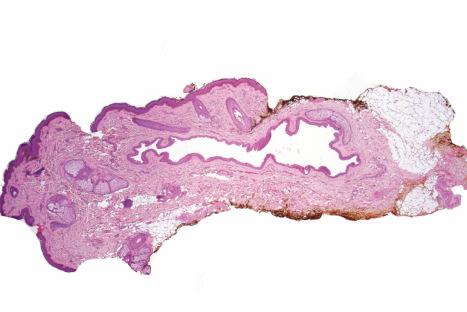
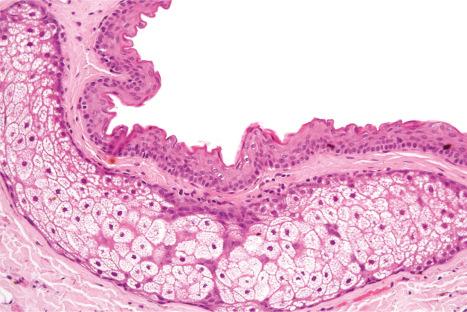
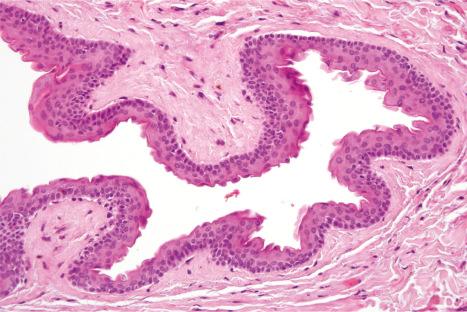
The lesions of steatocystoma multiplex and simplex are histologically indistinguishable.
Sebaceous adenoma is rare and frequently misdiagnosed clinically as a basal cell carcinoma. It presents most often in older people (mean age, 60 years) as a tan, pink-to-red, or yellow papulonodule measuring approximately 0.5 cm in greatest dimension. Occasionally, it has a polypoid appearance. The face (particularly the nose and cheek) and scalp are most often affected ( Figs 32.22 and 32.23 ). Less commonly affected sites include the ear and medial canthus, and occasionally lesions have been described on the trunk, leg, arm, and penis.
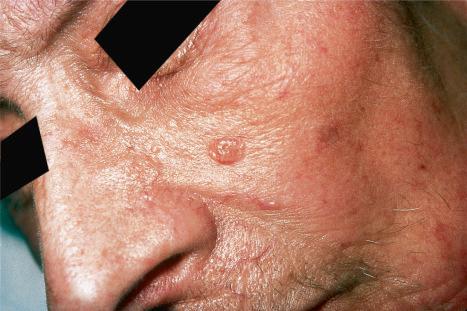
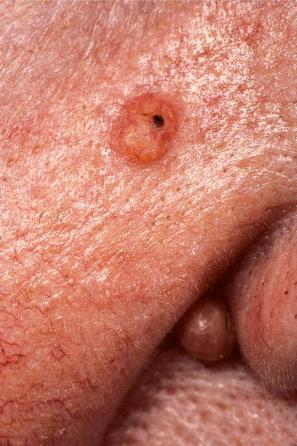
Sebaceous adenoma forms part of the spectrum of the Muir-Torre syndrome, particularly those that arise outside the head and neck region. Occasional reports have documented its presence in patients with the acquired immunodeficiency syndrome (AIDS). Rarely, it may develop intraorally, possibly in association with Fordyce papules. Sebaceous adenoma has rarely been described in the submandibular and parotid glands.
Inactivating mutations in LEF1 , the gene encoding a transcription factor in the Wnt/β-catenin pathway, have been documented in a subset of sebaceous adenomas. This pathway is involved in fate selection of follicular stem cells to adopt sebaceous differentiation and may also directly promote tumorigenesis. The hedgehog and c-Myc pathways may also be involved in tumorigenesis. Broader sequencing methods have revealed mutations in CDKN2A , EGFR , CTNNB1 , KRAS , and TP53 .
The tumor is multilobulated and sometimes appears to replace the surface epithelium ( Fig. 32.24 ). Individual lobules, often surrounded by a collagenous pseudocapsule, mirror the structure of a normal sebaceous gland. At the periphery are a variable number of layers of small germinative cells with round or oval vesicular nuclei and scanty cytoplasm. This increased number of basaloid or germinative cells allows separation from sebaceous hyperplasia, which has at most two layers of basal cells. The basaloid cells blend with the usually more centrally located mature sebaceous cells, which are much larger and have pale-staining foamy cytoplasm and central crenated hyperchromatic nuclei. Occasionally, peripheral palisading is a feature. Some lobules show cystic degeneration and others appear to communicate directly with the surface epithelium. By convention, more than half of the lobule in sebaceous adenoma is composed of mature sebaceous cells.

Sometimes, giant sebaceous adenomas are encountered which may show increased mitotic activity in the basaloid cell component ( Figs 32.25 and 32.26 ). This should not be interpreted as implying malignant potential.
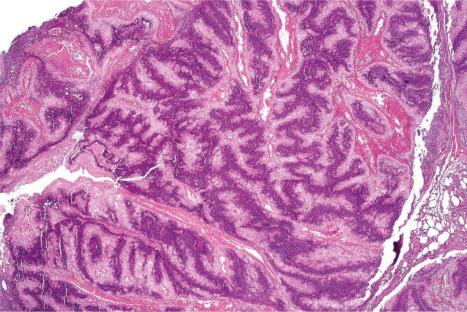
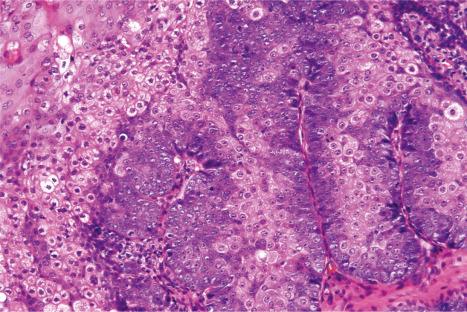
The intervening dermis may contain a chronic inflammatory cell infiltrate including lymphocytes, histiocytes, and plasma cells. An overlying cutaneous horn has been described.
A large study has shown substantial interobserver variation in the diagnosis of circumscribed sebaceous neoplasms within the categories of sebaceous adenoma, sebaceoma, and sebaceous carcinoma.
Few terms have caused as much confusion in dermatopathology as sebaceous epithelioma. This tumor has been variably recognized as a distinct lesion, as a variant of sebaceous adenoma, as an intermediate stage between sebaceous adenoma and basal cell carcinoma, and as a synonym for basal cell carcinoma with sebaceous differentiation. Troy and Ackerman introduced the term sebaceoma to help clarify this morass and proposed that the term sebaceous epithelioma be abandoned. Sebaceoma is clearly defined and distinguishable from sebaceous hyperplasia, sebaceous adenoma, and sebaceous carcinoma. Over time, use of sebaceous epithelioma as a diagnostic term has declined; most recent papers use this terminology primarily in the canine setting or historically in reviews. The publications that have documented tumors described as sebaceous epithelioma have illustrations that are clearly not those of basal cell carcinoma with sebaceous differentiation and are indistinguishable from the description of sebaceoma. While we have sympathy with the view of Dinneen and Mehregan that ‘the term sebaceous epithelioma has merit for historical reasons and because the tumor can be locally destructive’, we believe that its continued use will only perpetuate the confusion in the literature. Sebaceoma appears to be established as the diagnostic terminology of choice for this tumor and, as in the third and fourth editions, we have adopted the term sebaceoma and no longer recognize sebaceous epithelioma as an entity. The alternative term sebomatricoma, which includes sebaceous adenoma and sebaceoma as opposite ends of a spectrum of benign sebaceous tumors, has not received significant support in the literature.
Sebaceoma presents as a yellow-to-orange or flesh-colored papule, nodule, or tumor measuring approximately 1–3 cm in diameter ( Fig. 32.27 ). A giant variant measuring up to 6.0 cm in greatest dimension has also been described. The tumor presents more often in females (4:1) though one large recent series should support a more equal distribution and, while a wide age range may be affected (29–87 years), the majority of patients are in the sixth to ninth decades. Lesions predominantly affect the face and scalp, although a single report has described a case developing on the chest. Sebaceoma arising in continuity with a seborrheic keratosis has been documented and some examples have arisen within nevus sebaceous Importantly, sebaceoma may reflect associated Muir-Torre syndrome.
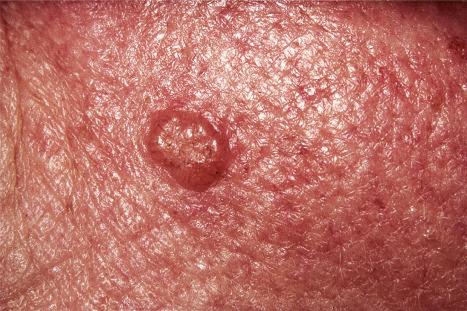
Recurrences or metastasis has not been reported.
Become a Clinical Tree membership for Full access and enjoy Unlimited articles
If you are a member. Log in here